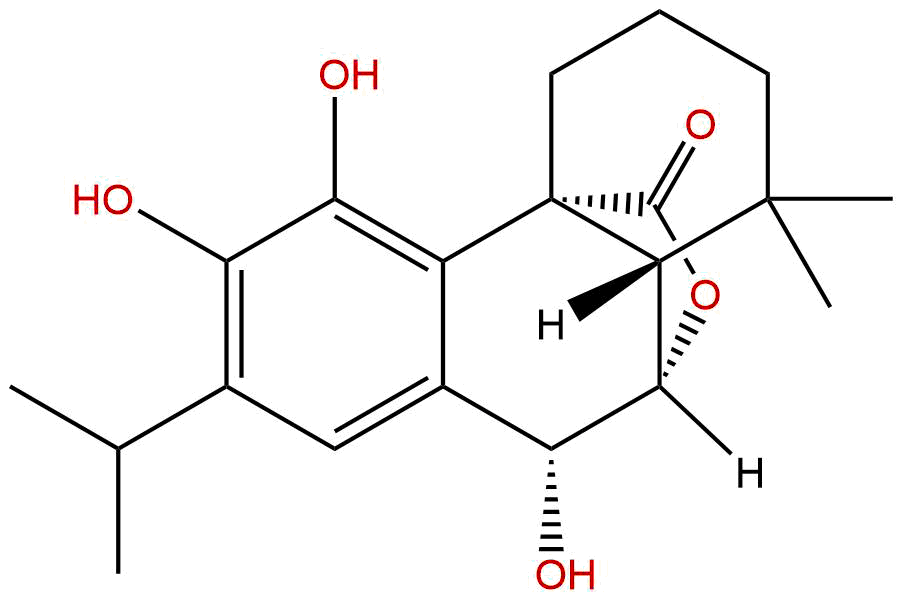
RosmanolCAS No.:80225-53-2
|
||||||||||
 |
|
|
||||||||

| Catalogue No.: | BP3643 |
| Formula: | C20H26O5 |
| Mol Weight: | 346.423 |
Product name: Rosmanol
Synonym name:
Catalogue No.: BP3643
Cas No.: 80225-53-2
Formula: C20H26O5
Mol Weight: 346.423
Botanical Source:
Physical Description:
Type of Compound: Phenylpropanoids
Purity: 95%~99%
Analysis Method: HPLC-DAD or/and HPLC-ELSD
Identification Method: Mass, NMR
Packing: Brown vial or HDPE plastic bottle
The product could be supplied from milligrams to grams. Inquire for bulk scale.
We provide solution to improve the water-solubility of compounds, thereby facilitating the variety of activity tests and clinic uses.
For Reference Standard and R&D, Not for Human Use Directly.
Description:
Rosmanol has antioxidant activity, it can activate the antioxidant response element, it also has biphasic modulation of GABAA receptors, demonstrates CNS activity in mouse models of antinociception, antidepressant and anxiolysis. Rosmanol exhibits significant cytotoxicity towards the neuroblastoma cells, it potently induces apoptosis through both the mitochondrial apoptotic pathway and death receptor pathway in human colon adenocarcinoma COLO 205 cells.Rosmanol has anti-inflammatory activity, it potently inhibits lipopolysaccharide-induced iNOS and COX-2 expression through downregulating MAPK, NF-kappaB, STAT3 and C/EBP signaling pathways.
References:
Acta Societatis Botanicorum Poloniae, 1997, 66(3-4):347-349.
Rosmanol controls explants browning of Hypericum Canariensis L. During the In Vitro establishment of shoots
An efficient method for eradication of browning exudate was developed for Hypericum canariensis.
METHODS AND RESULTS:
For this purpose the effect of natural products on browning exudates were investigated in four types of culture media: Murashige and Skoog (MS, 1962); Gamborg's (B5, 1979); Woody Plant Medium (WPM, Lloyd and McCown 1981) and modified Quoirin and Lepoivre (QL.4) (Mederos 1991, Mederos et al. 1995) basal macroelements; these basal macroelements were supplemented with the microelement formula described by Murashige and Skoog (MS, 1962). During the establishment of shoots organogenesis potential was achieved in the Murashige and Skoog (MS, 1962) and modified Quoirin and Lepoivre (QL. 4) (Mederos 1991, Mederos et al. 1995) media after browning exudates was eliminated by Rosmanol treatments.
CONCLUSIONS:
Rosmanol is a powerful diterpenic antioxidanl isolated from Salvia canariensis L., a medicinal species endemic to the Canary Islands.
J Pharm Pharm Sci. 2015;18(4):448-59.
Antidepressant, Anxiolytic and Antinociceptive Activities of Constituents from Rosmarinus Officinalis.
Recently, rosemary extracts standardized to diterpenes (e.g. carnosic acid and carnosol) have been approved by the European Union (EU) and given a GRAS (Generally Recognized as Safe) status in the United States by the Food and Drug Administration (FDA).
METHODS AND RESULTS:
Incorporation of rosemary into our food system and through dietary selection (e.g. Mediterranean Diet) has increased the likelihood of exposure to diterpenes in rosemary. In consideration of this, a more thorough understanding of rosemary diterpenes is needed to understand its potential for a positive impact on human health. Three agents in particular have received the most attention that includes carnosic acid, carnosol, and Rosmanol with promising results of anti-cancer activity. These studies have provided evidence of diterpenes to modulate deregulated signaling pathways in different solid and blood cancers. Rosemary extracts and the phytochemicals therein appear to be well tolerated in different animal models as evidenced by the extensive studies performed for approval by the EU and the FDA as an antioxidant food preservative.
CONCLUSIONS:
This mini-review reports on the pre-clinical studies performed with carnosic acid, carnosol, and Rosmanol describing their mechanism of action in different cancers.
Cancer Lett. 2015 Oct 28;367(2):93-102.
Diterpenes from rosemary (Rosmarinus officinalis): Defining their potential for anti-cancer activity.
Recently, rosemary extracts standardized to diterpenes (e.g. carnosic acid and carnosol) have been approved by the European Union (EU) and given a GRAS (Generally Recognized as Safe) status in the United States by the Food and Drug Administration (FDA).
METHODS AND RESULTS:
Incorporation of rosemary into our food system and through dietary selection (e.g. Mediterranean Diet) has increased the likelihood of exposure to diterpenes in rosemary. In consideration of this, a more thorough understanding of rosemary diterpenes is needed to understand its potential for a positive impact on human health. Three agents in particular have received the most attention that includes carnosic acid, carnosol, and Rosmanol with promising results of anti-cancer activity. These studies have provided evidence of diterpenes to modulate deregulated signaling pathways in different solid and blood cancers. Rosemary extracts and the phytochemicals therein appear to be well tolerated in different animal models as evidenced by the extensive studies performed for approval by the EU and the FDA as an antioxidant food preservative.
CONCLUSIONS:
This mini-review reports on the pre-clinical studies performed with carnosic acid, carnosol, and Rosmanol describing their mechanism of action in different cancers.
Nat Prod Lett. 2002 Aug;16(4):277-81.
Antioxidant capacity of abietanes from Sphacele salviae.
METHODS AND RESULTS:
Carnosol 1, Rosmanol 2, carnosic acid 3 and 20-deoxocarnosol 4, the main phenolic abietanes present in aerial parts of the Chilean medicinal plant Sphacele salviae were tested for antioxidant activity of measuring the decay of the radical cation diphenyl-picrylhydrazyl (DPPH).
CONCLUSIONS:
All compounds displayed higher antioxidant levels than BHT under the same conditions and carnosic acid was more efficient than vitamin E.